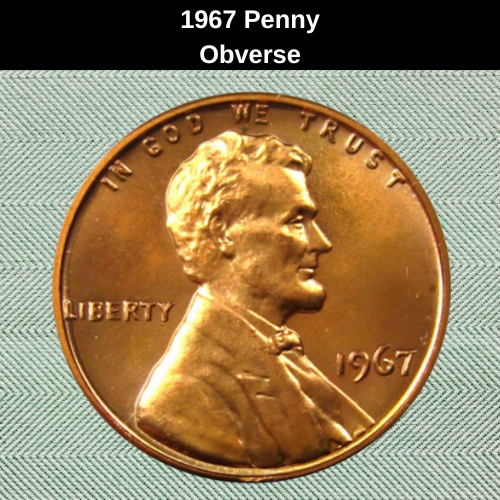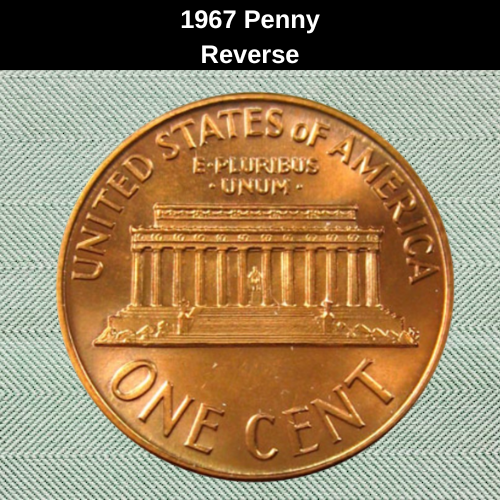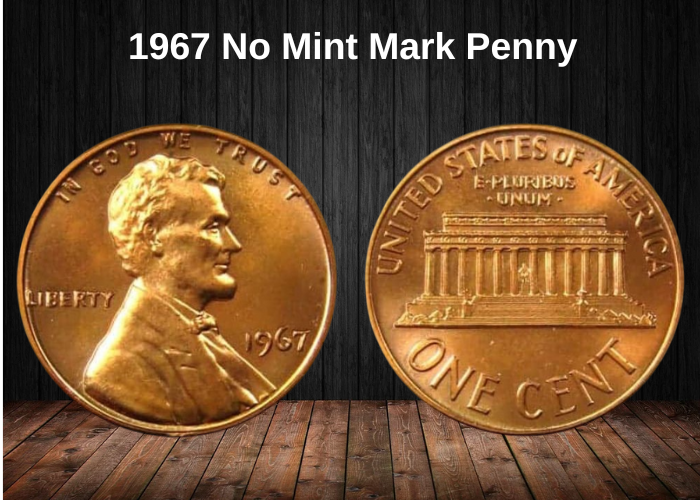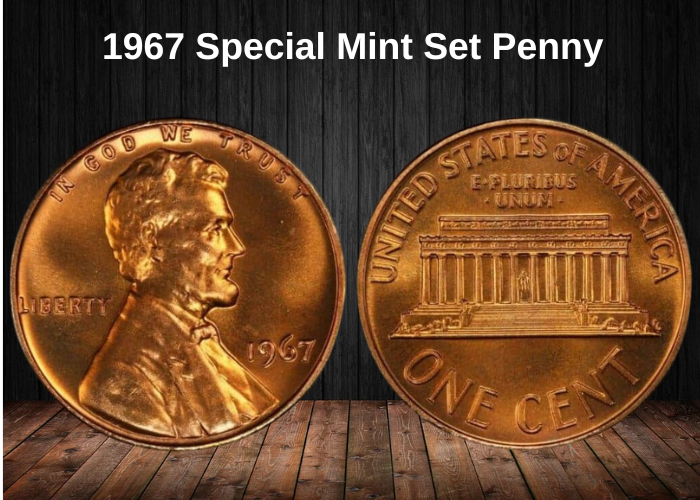The first Lincoln pennies featuring his portrait on the front were released in 1909. Fifty years later, the U.S. Mint replaced the iconic wheat ears on the coin’s back with an image of the Lincoln Memorial in Washington, D.C.
Like many coins in the Lincoln Memorial series, the 1967 penny generally holds modest value. Most of these modern cents remain quite affordable, except for a few that are in pristine condition. However, pieces from Special Mint Sets (SMS) tend to command higher prices.
1967 Penny Value Chart
| Condition | 1967 Penny (No Mint Mark) |
|---|---|
| MS 60 | $0.23 |
| MS 65 | $1.20 |
History of the 1967 Penny

The American cent has undergone numerous changes since its inception. Here’s a brief overview of its evolution in size, composition, and weight over time:
- 1793–1795: Large cents made of pure copper, weighing 208 grains (13.48 grams / 0.475 oz)
- 1795–1857: Slightly lighter pure copper large cents at 168 grains (10.89 grams / 0.384 oz)
- 1856–1864: Small cents composed of 88% copper, weighing 72 grains (4.67 grams / 0.165 oz)
- 1864–1942: Bronze (95% copper) small cents, 48 grains (3.11 grams / 0.110 oz)
- 1943: Zinc-coated steel cents, 42 grains (2.72 grams / 0.096 oz) — a wartime change
- 1944–1946: Return to 95% copper (gilding metal), still weighing 48 grains
- 1947–1962: Bronze composition continued, unchanged
- 1962–Sept. 1982: Gilding metal version of 95% copper remained in use
- From Oct. 1982 to present: Pennies became copper-plated zinc (95% zinc), weighing 2.5 grams (0.088 oz)
In 1967, the U.S. cent was still made of 95% copper and 5% tin or zinc. These coins fell into a unique period between 1965 and 1967, during which no mint marks were used—regardless of whether they were produced in Philadelphia, Denver, or San Francisco.
This decision aimed to curb coin hoarding during a national penny shortage. Notably, coins from 1967 were produced using outdated obverse hubs, giving Lincoln’s profile a soft, less-detailed appearance.
1967 Penny Types and Mintage
| Location | Type | Mintage |
|---|---|---|
| Philadelphia | No Mint Mark Penny | 3,048,667,100 |
| San Francisco | SMS (Special Mint Set) | 1,863,344 |
| Total | 3,050,530,444 |
Pennies from 1967 are historically interesting, as they reflect a time of change during the Vietnam War and the space race. The U.S. Mint was experimenting with production techniques, replacing traditional proof coins with SMS versions to streamline minting and discourage hoarding.
Features of the 1967 Penny
The obverse of Memorial cents retained Victor D. Brenner’s original portrait of Abraham Lincoln. However, after fifty years, the U.S. Mint introduced a new reverse design. Frank Gasparro, the selected designer, replaced the iconic wheat ears with the image of the Lincoln Memorial.
Coins from 1967 are typical representatives of the Memorial cent series. They follow the standard format in both design and quality, showing no distinctive features that set them apart from other issues of the era.
The obverse of the 1967 Penny

The 1967 pennies belong to the Memorial cent series, which replaced the Wheat penny design in 1959. Although the reverse was redesigned, the U.S. Mint retained Victor David Brenner’s original depiction of Abraham Lincoln on the obverse. His initials, V.D.B., can still be found beneath Lincoln’s shoulder.
In addition to Lincoln’s profile, the coin includes the word LIBERTY, a symbol of American ideals, and the date of issue. The phrase IN GOD WE TRUST is inscribed along the upper rim.
Despite being struck at multiple facilities in 1967, none of the regular circulation coins bear a mint mark beneath the date. This includes the SMS coins struck in San Francisco, which also lack the customary “S” mint mark—a deliberate choice aimed at discouraging coin hoarding during that period.
The reverse of the 1967 Penny

The reverse side of the 1967 Lincoln penny features the Lincoln Memorial, a design created by Frank Gasparro. His initials can be spotted near the base of the monument’s steps. What makes this coin particularly unique is that it shows Abraham Lincoln on both sides—his profile on the obverse and his statue within the Memorial on the reverse.
Alongside the central image of the Memorial, the design includes legally required inscriptions:
- UNITED STATES OF AMERICA
- E • PLURIBUS • UNUM
- ONE CENT
This reverse design remained in use from 1959 to 2008, until it was replaced by four new Bicentennial reverse designs honoring the 200th anniversary of Lincoln’s birth.
Specifications of the 1967 Lincoln Penny:
- Face Value: 1 cent
- Composition: 95% copper (gilding metal)
- Diameter: 0.75 inches (19 mm)
- Thickness: 0.059 inches (1.5 mm)
- Weight: 0.11 ounces (3.11 grams)
- Shape: Round
- Edge: Plain
Other Features of the 1967 Penny
The 1967 Memorial cent is composed primarily of copper, with a small amount of zinc or tin added to form a durable alloy. Each coin measures 0.75 inches (19 mm) in diameter, has a thickness of 0.06 inches (1.5 mm), and weighs approximately 0.11 ounces (3.1 grams). The edge of the coin is plain, consistent with standard one-cent pieces of the era.
1967 Penny Grading
You can easily estimate the condition and value of your 1967 penny using the Sheldon coin grading scale—specifically the modified version introduced in the 1970s, which is still the standard among professional grading services today. This scale ranks coins from 1 to 70, with each number representing a different quality level.
Here’s a simplified breakdown of the Sheldon scale:
| # | Grade Description |
|---|---|
| 1 | Basal State-1 |
| 2 | Fair |
| 3 | Very Fair |
| 4–6 | Good |
| 7–10 | Very Good |
| 12–15 | Fine |
| 20–30 | Very Fine |
| 40 | Extremely Fine |
| 50 | About Uncirculated |
| 60 | Mint State |
| 65 | Choice Mint State |
| 70 | Perfect Mint State |
Coin value increases with grade, especially in the uncirculated and mint state categories. Most 1967 pennies found in circulation today fall within the lower to mid-grade range, but coins that have been well-preserved or are part of Special Mint Sets (SMS) can receive significantly higher grades—and values.
Tip: Be sure to consult our grading guides or a reputable coin grading service to accurately assess your coin’s condition. It’s an essential step in determining its true market value.
1967 Penny Value Guides
Many collectors mistakenly assume that all 3,050,530,444 pennies minted in 1967 came from the Philadelphia Mint because none of them carry a mint mark. In reality, four different mints participated in production that year:
- Philadelphia: 907,575,000 regular strike pennies
- Denver: 1,327,377,100 regular strike pennies
- San Francisco: 813,715,000 regular strike pennies
- San Francisco (SMS): 1,863,344 Special Mint Set pennies with a satin finish
Because the U.S. Mint suspended the use of mint marks from 1965 to 1967 to discourage coin hoarding, it can be difficult to determine where a coin originated unless it’s part of a Special Mint Set (SMS).
Key Factors Affecting Value:
- Strike Type
- Regular strike coins are more common and usually less valuable.
- Special Mint Set (SMS) coins were never released into circulation and tend to be in superior condition, making them more valuable—especially at higher grades.
- Grade (Condition)
- The condition of a penny greatly influences its value. Coins in Mint State (MS) condition or higher often fetch a premium.
- Lower-grade coins can often be evaluated at home using the Sheldon Scale, but rare or high-value coins should be professionally graded by PCGS or NGC for accurate valuation and to achieve higher prices at auction.
- Rarity and Demand
- Some high-grade coins and error varieties (such as doubled dies or planchet errors) are highly sought after and can sell for hundreds or even thousands of dollars depending on their condition and uniqueness.
1967 No Mint Mark Penny Value

In 1967, the U.S. Mint produced 3,048,667,100 Lincoln Memorial cents without a mint mark. Due to their high copper content, these coins typically appear in three color designations: brown, red-brown, and red. Among them, red specimens are the most desirable to collectors, as they reflect minimal oxidation and superior preservation.
- Typical red coins range in value from $0.30 to $17, depending on their grade.
- Only examples graded MS 67 or higher command significantly higher prices, often valued around $450.
- The auction record for a 1967 red penny stands at $4,945.
Even lower-tier color designations can attract collector interest:
- A brown MS 70 penny sold for $2,650 on eBay in August 2021.
- A red-brown MS 65 specimen was purchased for $85, also on eBay, in 2018.
These examples demonstrate that while most 1967 pennies are common, exceptional condition and color can yield premium prices in today’s numismatic market.
1967 Special Mint Set Penny

The U.S. Mint did not issue proof pennies between 1964 and 1967, but instead, it released coins from the Special Mint Set (SMS), which were of higher quality than regular strikes but did not meet the standards of proof coins.
In 1967, the San Francisco Mint produced 1,863,344 SMS pennies without the mint mark. The objective behind this was to prevent hoarding and encourage more circulation of pennies in everyday transactions.
1967 SMS pennies are more valuable than regular coins, with prices varying depending on their condition:
- Red-colored coins:
- MS 65: $10
- MS 68: $175
- The highest price for a red SP 68 penny is $978.
- Other toned SMS pennies:
- Red-brown coin: Sold for $510 at auction.
- Brown-toned coin: Reached $103 on eBay in 2021.
Additionally, collectors often seek 1967 SMS CAM (Cameo) pennies, which are even more valuable. Their prices vary based on grade and toning:
- 1967 SP 65 penny (CAM): $110
- 1967 SP 66 penny (CAM): $200
- 1967 SP 67 penny (CAM): $775
- 1967 SP 68 penny (CAM): $6,000
The highest price for a CAM penny was $5,581, recorded in 2014. Furthermore, rare SMS DCAM (Deep Cameo) red cents in SP 65 grade are valued around $3,500, with a 2018 auction record of $3,360.
Rare 1967 Penny Error List
1967 Doubled Die Penny
The 1967 doubled die penny is a less sought-after error compared to more dramatic examples from 1955 or 1972. However, it still holds some value among collectors.
- Value Range: Depending on the visibility of the doubling, prices can range from $20 to $50.
- Significant Doubling: If the doubling is clearly visible to the naked eye, the coin’s price will be on the higher end of the spectrum.
- Minor Doubling: If the doubling is subtle and can only be seen with a magnifying glass, the coin’s value will be much lower, generally just a few dollars.
Collectors are particularly drawn to coins with more pronounced and noticeable doubling, making these pieces more desirable and valuable.
1967 Penny: Die Crack and Die Break
Coins with die cracks and die breaks occur when the dies used to strike them become worn out, cracked, or damaged over time. These imperfections result in visible traces on the coin’s surface, such as lines, bumps, or holes.
- Die Crack: A crack in the die can create a raised line on the surface of the coin. These cracks often form due to wear from repetitive use of the dies in the minting process.
- Die Break: A more severe form, a die break, occurs when a part of the die actually breaks off. This can cause larger holes or bumps on the coin.
Value:
- The price of these coins can vary based on the size and visibility of the crack or break.
- Small cracks or breaks: Typically worth $5 to $20.
- Larger or more noticeable imperfections: Can fetch $20 to $100 or more, depending on the size and visibility of the damage.
Although large die cracks or breaks have not been commonly seen in 1967 pennies, it’s still worth checking for these unique errors, as they can add collectible value to the coin.
1967 Penny: BIE Error
The BIE error occurs when there is a vertical die crack between the B and E in the word LIBERTY on the obverse of the coin. The crack causes the appearance of a second “I”, making it look like the word is spelled “LIBIERTY” instead of “LIBERTY.”
Value:
- Common Error: While this is a relatively common error among pennies, it still holds value due to its uniqueness.
- Value Range: You can expect to pay around $5 to $15 for a 1967 penny with this BIE error, depending on its condition and clarity.
1967 Penny: Double/Triple Strike
When a die strikes the blank planchet twice or three times, the result is a double or triple strike error, which can cause various deformities in the shape of the coin. These errors can be significant, with the coin appearing misaligned, with overlapping impressions from the repeated strikes.
- Value: Typically estimated at around $900, though some rare specimens may sell for even higher prices at auctions, depending on their quality and rarity.
1967 Penny: Cap Die Errors (Mushrooms, Bottle Caps)
A cap die error occurs when a penny gets stuck to the die after the first strike. As new coins are minted, these previously struck planchets continue to be struck, leading to mushroom-shaped or bottle cap-like deformations. These unusual and distorted pennies are popular among collectors.
- Value: Coins with this cap die error typically sell for around $25.
Where to sell your penny?
Now that you know the value of your penny, you might be wondering where to sell it. Don’t worry: here’s a guide to some of the best online platforms where you can easily sell your coins, along with their advantages and disadvantages.
Discover the best platforms for selling coins online (pros and cons).
FAQ about the 1967 Penny
1. What is the historical significance of the 1967 Lincoln Penny?
The 1967 Lincoln Penny is part of the Lincoln Memorial series, which ran from 1959 to 2008. The penny was minted during a time when U.S. coinage was undergoing significant changes. The most important change was that in 1965, the U.S. Mint began using clad compositions (copper-nickel) for other denominations like dimes and quarters, although the penny still retained its 95% copper composition until 1982. The 1967 penny is an important representation of this era of transition in U.S. coinage.
2. What is the composition of the 1967 Lincoln Penny?
The 1967 Lincoln Penny has the following composition:
- 95% copper
- 5% tin and zinc
This composition was standard for pennies minted from 1909 to 1982. The coin weighs 3.11 grams and measures 19.05 mm in diameter.
3. How many 1967 Lincoln Pennies were minted?
In 1967, the U.S. Mint produced the following numbers of Lincoln Pennies:
- Philadelphia Mint (no mintmark): 1,832,141,000
- Denver Mint (D mintmark): 1,255,220,000
This brings the total mintage for the 1967 Lincoln Penny to 3.09 billion, making it a very common coin in circulation. This high mintage means that the coin is not rare and is easily found in most collections or even in circulation today.
4. What is the value of a 1967 Lincoln Penny today?
The value of a 1967 Lincoln Penny depends on its condition. Since it is such a common coin, it typically only has significant value in higher grades. Here’s an approximate breakdown:
| Condition | 1967 (No Mintmark) | 1967-D |
|---|---|---|
| Circulated | $0.01–$0.05 | $0.01–$0.05 |
| Uncirculated (MS60) | ~$0.10–$0.25 | ~$0.10–$0.25 |
| MS63 Red | ~$1–$2 | ~$1–$2 |
| MS65 Red | ~$3–$5 | ~$3–$5 |
| With major errors | Varies ($10–$100+) | Varies ($10–$100+) |
The 1967 penny is generally worth face value if circulated. However, it may be worth a few dollars in higher grades, and coins with mint errors can be more valuable.
5. Are there any rare error varieties in the 1967 Lincoln Penny?
While the 1967 Lincoln Penny does not have any major design varieties, there are some error coins that may increase its value:
- Die cracks: Raised cracks can form on the coin’s surface, especially around the design features like the rim or Lincoln’s portrait.
- Off-center strikes: These occur when the planchet is not aligned properly during the minting process, leading to an off-center design.
- Clipped planchets: A coin with a portion of its edge missing due to a blanking error during production.
- BIE error: A die crack that appears between the “B” and “E” in “LIBERTY” that can look like an “I.”
These types of errors can make a 1967 penny more valuable, especially if the coin is in high grade.
6. How do I identify a high-grade 1967 Lincoln Penny?
A high-grade 1967 penny should have the following characteristics:
- Sharp details: The Lincoln portrait and wheat stalks on the reverse should be clearly defined with no signs of wear.
- Clean surface: A high-grade coin should have no scratches, marks, or discolorations. It should be relatively free from contact marks.
- Shiny luster: Uncirculated coins will have a shiny, reflective surface with minimal wear.
- Full rims: The coin’s rim should be well-defined and free of dents or wear.
Coins graded MS-65 or higher should show minimal imperfections and retain their original mint luster.
7. Is the 1967 Lincoln Penny worth collecting?
Although the 1967 Lincoln Penny is not a rare coin, it can still be of interest to collectors:
- For error collectors: If the coin has minting mistakes such as die cracks or off-center strikes, it could be worth collecting.
- For high-grade collectors: If you are collecting uncirculated or high-grade Lincoln pennies, the 1967 penny could be a valuable addition to your collection.
- For Lincoln Memorial series collectors: It is a key coin within the Lincoln Memorial series, and collectors who are trying to complete a full set of Lincoln pennies will need this year.
While it doesn’t have significant value in most cases, the 1967 Lincoln Penny may appeal to collectors looking for coins with mint errors, those building high-grade collections, or those interested in historical U.S. coinage.


















































